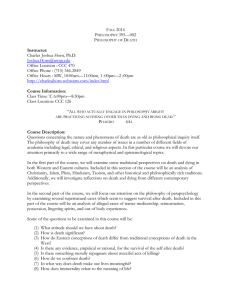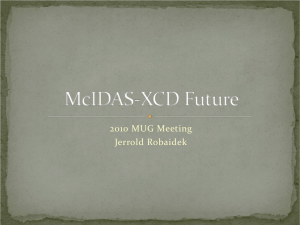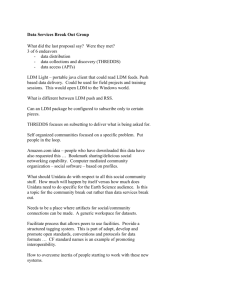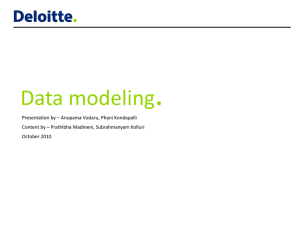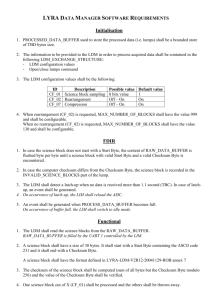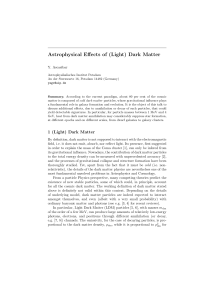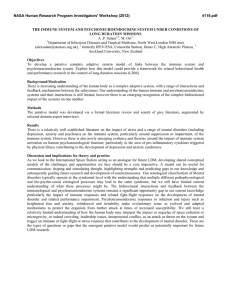Kelvin Droegemeier: Future of Project CRAFT: Technical Options, Costs, Scenarios
advertisement
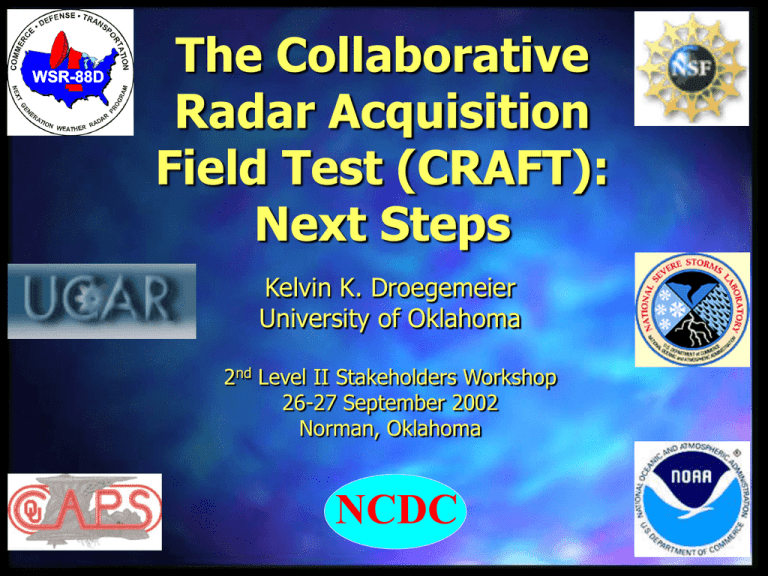
The Collaborative Radar Acquisition Field Test (CRAFT): Next Steps Kelvin K. Droegemeier University of Oklahoma 2nd Level II Stakeholders Workshop 26-27 September 2002 Norman, Oklahoma NCDC The Issues Before Us Grant funding for CRAFT communication links and personnel is nearly exhausted (data will stop flowing from CAPS sometime in November) The private and academic sectors are finding value in real time Level II data A real time Level II NWS collection system – is likely more than 1 year away – may not provide the latencies and reliability needed by the private sector for the short term – may be perfectly suited for meeting all needs in the longer term What options exist? How can we maximize the benefits to all stakeholders: Government, industry, academia? Options A wide range of potential options exists, all of which require Government approval – Shut CRAFT down and wait for the NWS system Timeline not yet defined Not clear the NWS system will meet non-Government user needs We likely won’t know until the system is in place If it does meet all user needs, we’re set If it does not, no alternative will exist (might take months to create) – Continue the present collaborative system (58 radars) or expand to all 120 NWS radars (lots of sub-options) – Create a stand-alone system that includes all 120 NWS WSR-88D radars, serves as a back-up to whatever the NWS implements, and has 7x24 support, improved reliability, etc Must consider administration of system (later in talk) The ideal perhaps is a partnership among all groups, with “partnership” defined many ways Suppose the NWS Deploys and Manages its Own Level II Distribution System (a very sensible approach) CRAFT as a Scalable System: The Current Concept Expanded for “Operational” Deployment Logical Network Topology LDM Server Logical Network Topology LDM Server OU At the moment, OU is the only server – Single points of failure (server and line from each radar) Logical Network Topology LDM Server Universities NOAA Laboratories NOAA Joint Institutes NCAR/UCAR MIT/Lincoln Lab NWS Regional HQ, NCEP Centers, RFCs Logical Network Topology LDM Server Universities NOAA Laboratories NOAA Joint Institutes NCAR/UCAR MIT/Lincoln Lab NWS Regional HQ, NCEP Centers, RFCs These already exist!! Logical Network Topology via phone lines or commodity Internet Commodity Internet LDM Server Abilene Backbone (no commercial traffic) LDM Server LDM Server LDM Server LDM Server LDM Server LDM Server LDM Server LDM Server LDM Server Abilene Network LDM Server LDM Server LDM Server Each LDM “Hub Site” Carries all 88D data on Abilene “bus”-- redundancy LDM Server LDM Server LDM Server Abilene Network LDM Server LDM Server LDM Server HUB HUB HUB HUB HUB HUB HUB LDM Server LDM Server LDM Server Abilene Network LDM Server LDM Server LDM Server LDM Server Commodity Internet LDM Server Commodity Internet LDM Server Abilene Network LDM Server Commodity Internet LDM Server LDM Server Commodity Internet Commodity Internet Commodity Internet LDM Server Commodity Internet LDM Server Commodity Internet LDM Server Abilene Network LDM Server Commodity Internet LDM Server LDM Server Commodity Internet Commodity Internet Commodity Internet LDM Server Commodity Internet LDM Server Commodity Internet LDM Server Abilene Network LDM Server Commodity Internet LDM Server LDM Server Commodity Internet Commodity Internet Commodity Internet LDM Server Commodity Internet LDM Server Commodity Internet LDM Server Abilene Network LDM Server Commodity Internet LDM Server LDM Server Commodity Internet Commodity Internet Commodity Internet Commodity Internet Commodity Internet LDM Server Commodity Internet LDM Server LDM Server Abilene Network LDM Server LDM Server Commodity Internet Customers LDM Server LDM Server Commodity Internet Commodity Internet Private Company LDM Server LDM Server LDM Server Abilene Network LDM Server LDM Server LDM Server Features of this Concept NOAA runs its own operational ingest system but allows connections to the BDDS of each NWS radar The CRAFT configuration – Is completely scalable to more nodes or radars – Is highly redundant (each major hub server contains all of the data) – Is highly reliable (loss of a major hub has minimal impact) – Leverages existing infrastructure – Links easily to other networks (e.g., AWIPS) – Has significant capacity for future growth (dual-pol, phased array) – Could have dual communication lines from each radar – Could serve as a backup system for the NWS Features of this Concept Many variants exist May require enhancements to LDM, e.g., multi-cast Must consider support of LDM to the commercial sector Key point is to create a national hierarchical distribution system along the lines of the current Unidata IDD Primary Ingest Node Source LDM LDM LDM Source Source LDM LDM LDM Internet LDM LDM LDM Source LDM LDM LDM Source Source LDM LDM LDM Internet LDM LDM LDM Relay Node Leaf Nodes Source LDM LDM LDM Source Source LDM LDM LDM Internet LDM LDM LDM 8 Scenarios (6 Detailed) and Provisional Costs Possible Scenarios Scenario #1: Maintain the current system of 58 radars with OU as the single ingest node – Assumptions Line charges paid by same groups as now, at the same rates Possible Scenarios Scenario #1: Maintain the current system of 58 radars with OU as the single ingest node – Assumptions Line charges paid by same groups as now, at the same rates – – – – – – 6 Sea Grant sites: $31K/year 6 SRP sites $72K/year 21 MIT sites $200K/year 4 Florida sites $5K/year 10 OU sites $80K/year 11 other sites FSL, NASA, GTRI, SLC, RAP, SEA (no cost estimates available) Total leveraging is ~ $450,000 per year Possible Scenarios Scenario #1: Maintain the current system of 58 radars with OU as the single ingest node – Assumptions Line charges paid by same groups as now, at the same rates No significant s/w development or 7x24 QOS Maintain current OU staff levels (C. Sinclair at 1.0 FTE and S. Hill at 0.5 FTE) $20K for h/w replacement, $10K for travel (per year) $1K for supplies (per year) KD, DJ, DE at 1 month each (1.0 FTE) (per year) – Yearly cost: $355,000 (could be reduced by shifting some existing lines to cheaper alternatives) – Advantages No additional h/w costs (above replacement) Continue using a proven reliable infrastructure Possible Scenarios – Disadvantages Not all radars are included Continue with heterogeneous communications infrastructure, latency problems Relies on existing groups to continue paying their local costs Little increase in QOS (i.e., no 7x24) 56K lines will continue to fall behind in weather Single ingest system at OU provides no redundancy Reliance upon university for private sector missioncritical needs No clear path to deal with data volume increase; however, this may not be critical if NWS system is available relatively soon Possible Scenarios Scenario #2: Same as Scenario #1, but add the remaining 64 NWS radars – Additional assumptions New CAPS technical staff member ($40K/year) for QOS and other work $100K in one-time costs for PCs $200K for one-time line installation costs and routers $50K in travel $5K for supplies $50K in h/w replacement costs and hot spares 30 new lines cost average of current OU lines; rest cost $50/month based on DSL/cable modem – Year-1 cost: $1.3M (could be reduced by shifting some existing lines to cheaper alternatives) – Beyond Year-1: Estimate $900,000/year Possible Scenarios – Advantages No additional h/w costs (above replacement) Continue using a proven reliable infrastructure All 120 NWS radars available Improved QOS via 2nd OU staff person Possible Scenarios – Disadvantages Not all radars are included Continue with heterogeneous communications infrastructure, latency problems Relies on existing groups to continue paying their local costs Little increase in QOS (i.e., no 7x24) 56K lines will continue to fall behind in weather Single ingest system at OU provides no redundancy Reliance upon university for private sector missioncritical needs Possible Scenarios Scenario #3: Same as Scenario #2, but add UCAR as a second Abilene ingest node – Additional assumptions $100K in computer hardware at UCAR One new UCAR technical staff member – Year-1 cost: $1.5M (could be reduced by shifting some existing lines to cheaper alternatives) – Beyond Year-1: Estimate $1.2M/year – Note: Could possibly add MIT/LL as third redundant node, but this has not been discussed with them Possible Scenarios – Advantages No additional h/w costs (above replacement) Continue using a proven reliable infrastructure All 120 NWS radars available Improved QOS via 2nd OU staff person Greatly improved redundancy, reliability, latencies Possible Scenarios – Disadvantages Not all radars are included Continue with heterogeneous communications infrastructure, latency problems Relies on existing groups to continue paying their local costs Little increase in QOS (i.e., no 7x24) 56K lines will continue to fall behind in weather Single ingest system at OU provides no redundancy Reliance upon university for private sector missioncritical needs (not clear that UCAR can provide needed QOS) Scenario Summaries (1-3) No. Radars Ingest Nodes Communications Infrastructure QOS Yearly Cost Scenario 1 58 OU Current Heterogeneous Mix* Low $0.36M Scenario 2 122 OU Current Heterogeneous Mix* Med $1.3M (Yr 1) $0.9M (Yr 2) Scenario 3 122 OU & UCAR** Current Heterogeneous Mix* High $1.5M (Yr 1) $1.2M (Yr 2) * Leverages $450K/year paid by other organizations ** Could try and add MIT/LL as third node Possible Scenarios Scenario #4: Same as Scenario #3, but with a national telecommunications carrier providing uniform delivery service to the additional 64 radars only – Additional assumptions AT&T line costs for 2-year contract for 64 additional radars is $850,000/year. Mixture of T1, DSL Note that these costs have not been negotiated and likely could be reduced substantially (might also be able to eliminate T1 lines) Removes need for one-time installation charges and router costs Still have the costs of the 64 new LDM PCs – Yearly cost: $2.1M (hope this could be brought down to $1.6 or $1.7M with tough negotiation) Possible Scenarios – Advantages No additional h/w costs (above replacement) Continue using a proven reliable infrastructure All 120 NWS radars available Improved QOS via 2nd OU staff person Greatly improved redundancy, reliability, latencies Uniform networking for 64 radars QOS should be much higher (AT&T rapid response) Possible Scenarios – Disadvantages Not all radars are included PARTLY heterogeneous communications infrastructure, latency problems Relies on existing groups to continue paying their local costs Little increase in QOS (i.e., no 7x24) 56K lines will continue to fall behind in weather Single ingest system at OU provides no redundancy Reliance upon university for private sector missioncritical needs Scenario Summaries (1-4) No. Radars Ingest Nodes Communications Infrastructure QOS Yearly Cost Scenario 1 58 OU Current Heterogeneous Mix* Low $0.36M Scenario 2 122 OU Current Heterogeneous Mix* Med $1.3M (Yr 1) $0.9M (Yr 2) Scenario 3 122 OU & UCAR** Current Heterogeneous Mix* High $1.5M (Yr 1) $1.2M (Yr 2) Scenario 4 122 OU & UCAR** AT&T for New 64 Radars High $1.6 to $2.1M * Leverages $450K/year paid by other organizations ** Could try and add MIT/LL as third node Possible Scenarios Scenario #5: Same as Scenario #4, but with a national telecommunications carrier providing uniform delivery service to all radars – Additional assumptions AT&T line costs for 2-year contract for all radars is $1.4M/year. Mixture of T1, DSL Note that these costs have not been negotiated and likely could be reduced substantially (might also be able to eliminate T1 lines) Removes need for one-time installation charges and router costs Still have the costs of the 64 new LDM PCs – Yearly cost: $2.8M (hope this could be brought down to $2.2 or $2.3M with tough negotiation) Possible Scenarios – Advantages No additional h/w costs (above replacement) Continue using a proven reliable infrastructure All 120 NWS radars available Improved QOS via 2nd OU staff person Greatly improved redundancy, reliability, latencies Uniform networking for ALL radars QOS should be much higher (AT&T rapid response) Increased bandwidth needs (e.g., dual-pol, new VCP, ¼ km by ½ degree resolution) could be handled by the telecomm carrier “automatically” Possible Scenarios – Disadvantages Not all radars are included PARTLY heterogeneous communications infrastructure, latency problems Relies on existing groups to continue paying their local costs Little increase in QOS (i.e., no 7x24) 56K lines will continue to fall behind in weather Single ingest system at OU provides no redundancy Reliance upon university for private sector missioncritical needs Scenario Summaries (1-5) No. Radars Ingest Nodes Communications Infrastructure QOS Yearly Cost Scenario 1 58 OU Current Heterogeneous Mix* Low $0.36M Scenario 2 122 OU Current Heterogeneous Mix* Med $1.3M (Yr 1) $0.9M (Yr 2) Scenario 3 122 OU & UCAR** Current Heterogeneous Mix* High $1.5M (Yr 1) $1.2M (Yr 2) Scenario 4 122 OU & UCAR** AT&T for New 64 Radars High $1.6 to $2.1M Scenario 5 122 OU & UCAR** AT&T for ALL Radars High $2.2 to $2.8M * Leverages $450K/year paid by other organizations ** Could try and add MIT/LL as third node Other Scenarios Scenario #6: Use NWS River Forecast Centers as points of aggregation – May make sense only if the NWS wishes to pursue a non-AWIPS collection strategy – The general CRAFT concept still could be applied Scenario #7: Use the Planned NWS Distribution System Scenario #8: Create a System Operated Entirely by the Private Sector (no university or UCAR involvement) Administrative Structure Points of Reference (for the sake of argument) – Must be able to ensure 7x24 service (high reliability) – Latency must be as low as possible – Government receives data at no cost but could/should cost share overall expenses in light of benefits to NCDC (direct ingest for long-term archive), NCEP, FSL, NWS Offices (Level II recorders) – Educational institutions receive data at no cost – Presumably don’t want another “NIDS arrangement” Options – – – – – For-profit private company University-based consortium Not-for-profit 501(c)3 University-based center (e.g., Wisconsin for satellite data) Others? Key Items for Discussion Sustaining the operation of CRAFT beyond November Establishing private sector requirements – Reliability – Latency – Hardware and software support Meeting private (and academic) sector needs in the short, medium and long term Administrative issues (including data access rules) Dealing with future data volumes Further analysis of system capabilities – Impact of weather on data reliability/latency – Networking simulation
